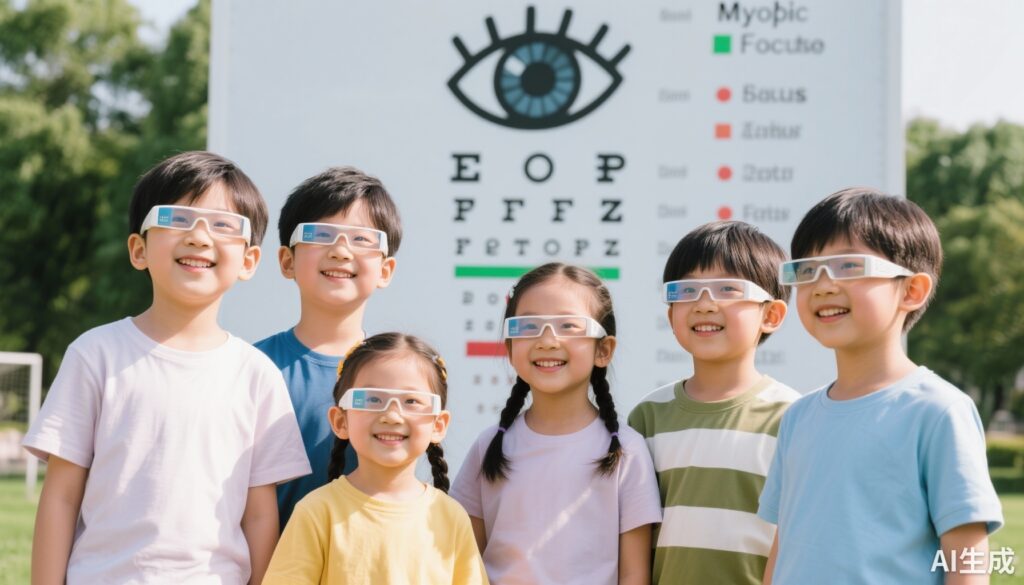Highlight
- DSDO spectacle lenses significantly reduce 1-year myopia incidence and fast myopic shift in children aged 5-12 compared to single-vision spectacles.
- Adjunctive use of 0.01% atropine eye drops with DSDO lenses did not confer additional significant benefit over DSDO lenses alone.
- These findings support the efficacy of non-pharmacologic optical intervention for primary myopia prevention in children without baseline myopia.
Study Background and Disease Burden
Myopia, or nearsightedness, is a refractive error characterized by the elongation of the eyeball leading to blurred distance vision. Globally, myopia prevalence has been rapidly rising, particularly among children in East Asia, with projected increases posing significant public health challenges. Early-onset myopia is associated with higher risks of pathological complications such as retinal detachment, myopic maculopathy, and glaucoma in adulthood. Hence, effective prevention strategies targeting children before myopia onset are urgently needed.
Optical interventions designed to modify focal planes on the retina have evolved as promising non-invasive approaches to prevent or slow myopia progression. Among these, diversified segmental defocus optimization (DSDO) lenses aim to deliver controlled peripheral myopic defocus to regulate axial elongation. Pharmacologic treatment with low-dose atropine has also shown efficacy in slowing myopia progression but is commonly used once myopia develops. This study evaluates DSDO lenses with and without 0.01% atropine eye drops to assess their role in primary myopia prevention in children without myopia at baseline.
Study Design
This randomized, placebo-controlled, double-masked clinical trial was conducted at the Department of Ophthalmology, Peking University People’s Hospital, between November 2023 and December 2024. Children aged 5 to 12 years with cycloplegic spherical equivalent refraction (SER) between 0.00 and +1.00 diopters were eligible. Exclusion criteria included pre-existing ocular or systemic diseases and prior use of optical or pharmaceutical myopia control treatments.
Participants (n=450) were randomized in a 1:1:1 ratio to three intervention groups:
– DSDO spectacles plus placebo eye drops (DSDO group)
– DSDO spectacles plus 0.01% atropine eye drops (DSDOA group)
– Single-vision (SV) spectacles plus placebo eye drops (control group)
Primary outcomes were the 1-year cumulative incidence of myopia (SER ≤ -0.50 D) and the proportion exhibiting a fast myopic shift (≥0.50 D increase in myopia) over 1 year. Secondary outcomes included changes in SER, axial length, and subfoveal choroidal thickness assessed through standard ophthalmic measurements.
Key Findings
Among 450 randomized children, 370 (82.2%) completed the 1-year follow-up (DSDO: 121, DSDOA: 125, control: 124). Baseline demographic and refractive parameters were balanced across groups.
The 1-year cumulative incidence rates of myopia were significantly lower in the DSDO (5.8%) and DSDOA (4.8%) groups compared to controls (15.3%). The risk differences versus control were 9.5% (95% CI, 1.9–17.5; P=0.02) for DSDO and 10.5% (95% CI, 3.3–18.4; P=0.006) for DSDOA.
Similarly, fast myopic shift occurred less frequently in intervention groups: 15.7% in DSDO and 9.6% in DSDOA versus 42.7% in controls. The absolute reductions were 27.0% (95% CI, 16.1–37.3; P<.001) for DSDO and 33.1% (95% CI, 23.1–42.8; P<.001) for DSDOA.
Changes in secondary outcomes supported these findings, with smaller myopic progression and axial elongation observed in DSDO and DSDOA groups. No statistically significant differences emerged between DSDO lenses alone versus DSDO plus atropine, suggesting that atropine did not add clinically meaningful benefit within one year when combined with DSDO spectacle use.
The trial reported no serious adverse events. Both optical and pharmacologic interventions were well tolerated, and compliance was high.
Expert Commentary
This landmark randomized trial provides compelling evidence that daily use of DSDO spectacle lenses effectively delays myopia onset in children at risk but not yet myopic, representing a novel primary prevention strategy. The substantial absolute reductions in myopia incidence and fast progression suggest robust clinical utility, potentially alleviating the global myopia burden.
While low-dose atropine monotherapy is established for myopia control post-onset, its lack of added benefit alongside DSDO lenses in this preventive context is notable. This may be due to overlapping or saturable mechanisms controlling ocular growth, or the short 1-year duration limiting differentiation of subtle effects.
The study aligns with biological plausibility models where engineered retinal defocus alters retinal signaling to modulate axial length growth. Further mechanistic studies could elucidate interaction pathways between optical defocus and pharmacologic pathways such as muscarinic receptor modulation.
Limitations include modest sample size and follow-up duration; longer longitudinal studies are needed to confirm sustainability of benefits and evaluate outcomes into adolescence. External validation across diverse ethnic groups and environments will strengthen generalizability.
Conclusion
This rigorous randomized clinical trial demonstrates that diversified segmental defocus optimization spectacle lenses used daily can significantly reduce myopia incidence and progression in non-myopic children over 1 year. Adjunctive 0.01% atropine eye drops do not provide additional short-term prophylactic benefit. These findings support adoption of DSDO lenses as an effective non-pharmacological strategy for primary myopia prevention in children, potentially mitigating future burdens of myopia-related ocular morbidity. Continued longitudinal and mechanistic research is warranted to optimize integrated prevention approaches.
References
1. Lu Y, Yang X, Zhou J, Chen S, Li X, Deng Y, Zhang Y, Li Y, Wang K. Diversified Segmental Defocus Optimization Lenses With and Without Atropine for Myopia Prevention: A Randomized Clinical Trial. JAMA Ophthalmol. 2025 Aug 1;143(8):684-691. doi: 10.1001/jamaophthalmol.2025.2072. PMID: 40638107; PMCID: PMC12246953.
2. Morgan IG, Ohno-Matsui K, Saw SM. Myopia. Lancet. 2012 May 5;379(9827):1739-48.
3. Wu PC, Tsai CL, Wu HL, Yang YH, Kuo HK. Outdoor activity during class recess reduces myopia onset and progression in school children. Ophthalmology. 2013 May;120(5):1080-5.
4. Yen SL, Teng MC, Wu PC, et al. Prevention and control of myopia: National consensus guidelines. Taiwan J Ophthalmol. 2022;12(3):217-227. doi:10.4103/tjo.tjo_66_22.


